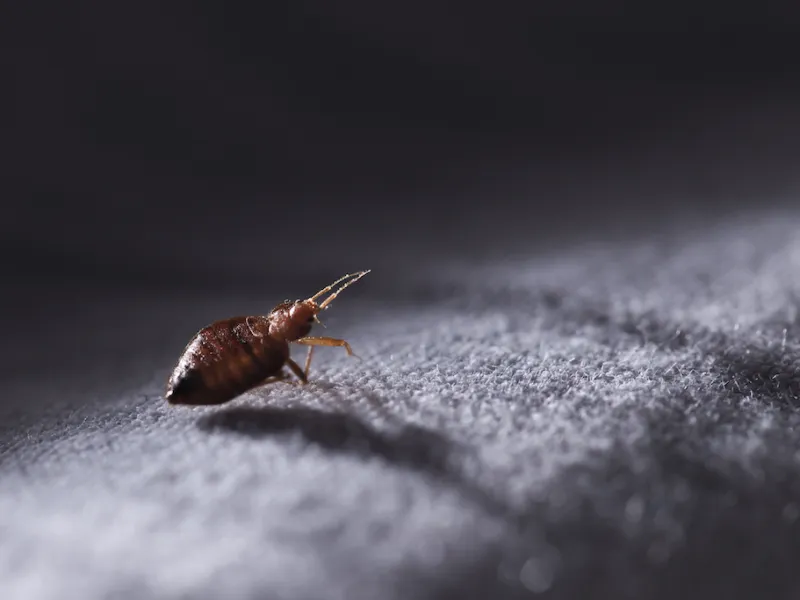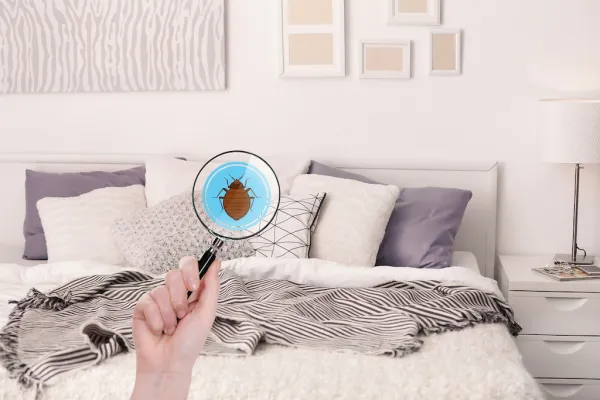Good Night, Sleep Tight (A Guide to NOT Letting the Bed Bugs Bite)

"Good night, sleep tight, don't let the bed bugs bite." You've probably heard this rhyme a thousand times before. Of course, no one ever expects to actually have pests in their bed. But these sneaky little critters are actually more common than you think, feeding on both humans and pets. They multiply quickly, and they're small enough to fit on the head of a pin. If they sound like something out of a horror movie (and they do), don't worry—your local pest control experts at Palmetto Exterminators are here to give you all the information you need to keep bed bugs from being tucked in with you.
Know Your Enemy: Bed Bug FAQs
What Are Bed Bugs?
These notorious critters have made headlines across the nation time and time again. Why? Because they are notorious for being one of the most difficult pests to get rid of for good. Their ability to travel on bags, clothing, linens, and other fabrics allows them to spread at an alarming rate. But, what are they?
Bed bugs are small, flat, wingless parasites that feed on the blood of people and animals while they sleep. There are two specific kinds of bedbugs that have the reputation of feeding on human blood: Cimex hemipterus and Cimex lectularius.
What Do Bed Bugs Look Like?
Full-grown bed bugs are still tiny, but when there's one, there are often many more, so identifying the problem by sight is usually the most effective way to tell when you have an infestation.
Their bodies are flat, round, and brown with a tiny head—similar to the shape of a tick—although an adult bed bug is still only approximately ¼ of an inch long. They often produce a distinctively sweet, musty smell that can linger on your sheets.
When Is Bed Bug Season?
Though they are technically a year-round pest, bed bugs are most active in the late summer and early fall, from June to October. But beware, as life begins to return back to normal (or, at the very least, a new normal) and travel continues to ramp up, so do the number of bed bug infestations.
If you are planning on traveling during peak season, maybe a last hoorah before school starts again, make sure to stay alert and take the proper precautions to avoid unintentionally bringing these critters back home with you.
What's the Life Cycle of Bed Bugs?
A bed bug has a lifespan of approximately 2 to 4 months, during which time each female will lay up to 250 eggs. These eggs are only about 1mm large and will hatch within about a week. Nymph bugs are white and tiny and can be almost impossible to see with the naked eye.
By the time the next generation has grown to their adult stage, your infestation will be multiplying at a very concerning rate. And, unfortunately, one of the reasons they are difficult to get rid of (besides being able to travel) is because they don't die off in the winter.
Are Bed Bugs Dangerous?
While they are difficult to get rid of, the good news is that bed bugs do not transmit diseases. However, their bites are certainly no walk in the park, leaving large, red, painful,l and itchy welts that look and feel quite like mosquito or chigger bites. The severity of the reaction depends on the person, however, some may experience more severe allergic reactions after a bed bug bite.
Most of the time, though, you won't even realize that you were bitten by one, as their saliva acts as an anesthetic that numbs the skin and promotes blood flow. It's after the feeding that should concern you. A full bed bug will hideout for 5 to 10 days to digest their meal (you)—and worse, lay eggs. This is when infestations occur.
Where Are Bed Bugs Found?
These pests aren't picky and are found across the globe. Previously thought to be mainly in developing countries, bed bugs have spread to many parts of the U.S., U.K., Canada, and Europe in recent years. They are often found in areas where people sleep such as apartments, hostels, shelters, hotels, cruise ships, buses, trains, and dorm rooms.
And their presence isn't determined by cleanliness — bed bugs can be found even in the most luxurious and well-kept 5-star hotel or resort. Typically, they hide during the day within an 8-foot vicinity of where people sleep, in mattress seams, box springs, bed frames, headboards, dresser drawers, and more. However, if you have a bed bug problem on your hands, they can make themselves comfortable just about anywhere.
5 Surprising Spots Where Bed Bugs Hide
Keep in mind, bed bugs are very active in their search for new food, sometimes traveling up to 100 feet in a night. While they tend to gravitate toward fibrous materials, bed bugs can be found in other unexpected spots, too. So, if you are working on eliminating a bed bug infestation or would just like to do a post-trip check, here are a few places to search that you may not have considered.
1 - Carpets and Rugs
Bed bugs love nesting in fibrous material, but that does not mean that they limit themselves to your bed. They do not have wings, and unlike fleas and ticks, they are not particularly strong jumpers. Instead, they crawl as they spread, which means that carpets and rugs provide a huge, comfortable space for bed bugs to live and breed.
2 - Plugs and Appliances
At only a few millimeters in length, bed bugs can (and will) fit into almost anything. As they search for shelter, consider that most bedroom sets have at least one electrical outlet immediately next to the bed. Bed bugs can easily fit in this space and into all of the cracks and crevices in the connecting furniture and appliances, making the infestation much harder to eliminate as they spread.
3 - Walls
Speaking of cracks and crevices, bed bugs have been known to nestle into the tiniest gaps in floorboards, in the corners of walls and floors, in moldings, and behind wallpaper and picture frames. These little bugs spread out in three dimensions, which is yet another reason why they can be so difficult to eliminate.
4 - Chairs and Couches
Because bed bugs have the ability to travel, no furniture is safe—especially in your bedroom. If the infestation gets out of hand, these critters will inevitably space out to your couches, chairs, benches, and ottomans. These resting areas have all of the traits of a bed bug's favorite target; they're big, fibrous, and the occasional dozer-offer provides a quick meal.
5 - Gears, Tracks, and Furniture Screws
Bed bugs are so small and multiply so quickly that a bad case of bed bugs can corrupt even the most difficult-to-reach spaces. These tiny pests can wedge themselves into the threads of a screw, they can squeeze into the tracks of your drawers, and they can crawl into the mesh of a speaker.
Know When to Call in the Cavalry
We cannot stress this enough: if you think you have a bed bug problem (or any pest for that matter), it's important to handle it immediately. Stained sheets, unexplained bites, or a musty odor can be telltale signs of bed bugs. If you notice any of these warnings, give Palmetto Exterminators a call immediately. Our local exterminators can help you eliminate the threat and reclaim your home immediately. Bed bugs can be a nuisance, but with one of our friendly Palmetto Exterminators in your corner, they don't have to be something you lose sleepover.


